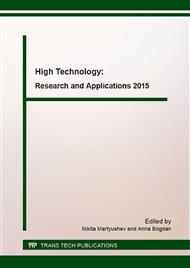[1]
Davim, J. P., & Reis, P. (2004).
Google Scholar
[2]
Hanafi, I., Khamlichi, A., Cabrera, F. M., Almansa, E., & Jabbouri, A. (2012). Optimization of cutting conditions for sustainable machining of PEEK-CF30 using TiN tools. Journal of Cleaner Production, 33, 1-9.
DOI: 10.1016/j.jclepro.2012.05.005
Google Scholar
[3]
Hanafi, I., Khamlichi, A., Cabrera, F. M., Nuñez López, P. J., & Jabbouri, A. (2012).
Google Scholar
[4]
Mata, F., Gaitonde, V. N., Karnik, S. R., & Davim, J. P. (2009).
Google Scholar
[5]
Paulo Davim, J., Reis, P., Lapa, V., & Conceiçao António, C. (2003). Machinability study on polyetheretherketone (PEEK) unreinforced and reinforced (GF30) for applications in structural components. Composite Structures, 62(1), 67-73.
DOI: 10.1016/s0263-8223(03)00085-0
Google Scholar
[6]
Mahdi, M., & Zhang, L. (2001). A finite element model for the orthogonal cutting of fiber-reinforced composite materials. Journal of Materials Processing Technology, 113(1-3), 373-377.
DOI: 10.1016/s0924-0136(01)00675-6
Google Scholar
[7]
Arola, D., & Ramulu, M. (1997). Orthogonal cutting of fiber-reinforced composites: A finite element analysis. International Journal of Mechanical Sciences, 39(5), 597-613.
DOI: 10.1016/s0020-7403(96)00061-6
Google Scholar
[8]
Bhatnagar, N., Ramakrishnan, N., Naik, N. K., & Komanduri, R. (1995). On the machining of fiber reinforced plastic (FRP) composite laminates. International Journal of Machine Tools and Manufacture, 35(5), 701-716.
DOI: 10.1016/0890-6955(95)93039-9
Google Scholar
[9]
Wern, C. W., Ramulu, M., & Shukla, A. (1996). Investigation of stresses in the orthogonal cutting of fiber-reinforced plastics. Experimental Mechanics, 36(1), 33-41.
DOI: 10.1007/bf02328695
Google Scholar
[10]
Zhang, L. (1999). On the separation criteria in the simulation of orthogonal metal cutting using the finite element method. Journal of Materials Processing Technology, 89-90, 273-278.
DOI: 10.1016/s0924-0136(99)00023-0
Google Scholar
[11]
O. Ghouati, J.C. Gelin, Identification of material parameters directly from metal forming processes, J. Material Processing Technology, 80-81, (1998) 560-564.
DOI: 10.1016/s0924-0136(98)00159-9
Google Scholar
[12]
O. Ghouati, J.C. Gelin, A finite element based identification method for complex material behaviours, Computational Materials Science, 21, (2001) 57-68.
DOI: 10.1016/s0927-0256(00)00215-9
Google Scholar
[13]
A. Maurel, M. Fontaine, S. Thibaud, G. Michel, J.C. Gelin, Experiments and FEM Simulations of Milling Performed to Identify Material Parameters, Int J Mater Form (2008) 1: 1435-1438.
DOI: 10.1007/s12289-008-0106-0
Google Scholar
[14]
Khaimovich, А. Balaykin, A. Kondratiev, A. (2014).
Google Scholar
[15]
Khaimovich, А. Balaykin, A. (2014).
Google Scholar
[16]
Kudo, H. (1959) An Upper Bound Approach to Plane Strain Forging and Extrusion, Int J of Mech. Sciences (Parts I and II), p.229.
Google Scholar
[17]
Johnson, G.R.; Cook, W.H. (1983), A constitutive model and data for metals subjected to large strains, high strain rates and high temperatures, Proceedings of the 7th International Symposium on Ballistics: 541–547.
Google Scholar
[18]
Khaimovich, А. Balaykin, A. (2014) Analysis of plastic properties of titanium alloys under severe deformation conditions in machining, International Journal of Engineering and Technology, 6(5): 2184-2190.
Google Scholar
[19]
Khaimovich, А. Balaykin, A. Galkina, N. (2015) Study of Rheological Properties of Materials at the Blade Processing on Example of Milling Nickel-Chromium Alloy 10H11N23T3 MR VD, Applied Mechanics and Materials, vol. 756 (2015) pp.120-125.
DOI: 10.4028/www.scientific.net/amm.756.120
Google Scholar


